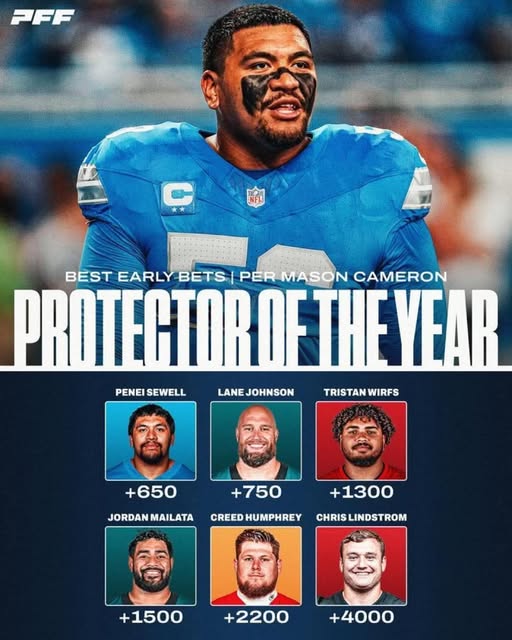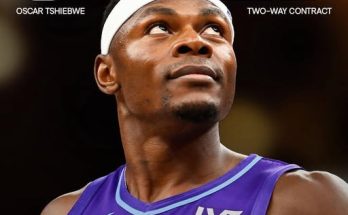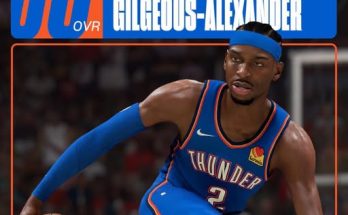The modern NFL lineman is forged in the crucible of power, precision, intelligence, and relentless effort. Their work is the quiet foundation—the protective fortress that makes stars shine, running backs rumble, and quarterbacks flourish. In an age defined by high‑stakes offenses and explosive athleticism, a few exceptional linemen stand head and shoulders above their peers. They bend the will of defenders, carve lanes in congested chaos, stand tall in the pocket, and elevate entire offenses. Their value is immeasurable. Among them, a handful of transcendent talents rule supreme: Penei Sewell, Lane Johnson, Trent Williams, Quenton Nelson, and interior masters like Zack Martin and Landon Dickerson. These athletes—through a fusion of skill, consistency, and dominance—make a compelling case as the best lineman in the NFL.
Penei Sewell of the Detroit Lions, still in his mid‑20s, has already accumulated an astonishing resume: three straight All‑Pro nods, three Pro Bowl selections (2022–2024), and zero missed games over four seasons . His blend of size (6’5″, 335 lbs), agility, and football IQ belies his age and makes him a top candidate for the inaugural NFL “Protector of the Year” award . Pro Football Focus ranked Detroit’s offensive line—anchored by Sewell and center Frank Ragnow—second in the league overall, underscoring Sewell’s impact as elite on both run and pass protection . His durability and consistency—remaining in his starting spot since rookies days—cement his standing among the NFL’s best.
Lane Johnson of the Philadelphia Eagles may well be the modern prototype of a premier right tackle. Entering his 35‑year season yet gliding with the athleticism of men a decade younger, Johnson earned another Pro Bowl nod and second‑team All‑Pro honors in 2024 ( NFL analysts named him the top candidate for “Protector of the Year,” citing his combination of length, power, durability, and technical excellence . As one analyst observed, “his smoothness and athleticism are nearly unmatched,” and he remains a lynchpin for one of the NFL’s most formidable line units . Lane Johnson is more than a blocker; he’s a cornerstone of offensive identity, leadership, and execution.
Meanwhile, Trent Williams of the San Francisco 49ers occupies an elite tier reserved for transcendent, ageless linemen. A future Hall of Famer, Williams has been a marvel of elite play for over a decade . He allowed just one sack in the last season, with PFF confirming his continued dominance even at 36–37 years old . Durability, strength, technique—Williams embodies them all. If the hall of Protectors award existed earlier, Williams would be a multi‑time winner. He is the book‑end defining excellence at tackle.
As powerful as the tackles are, interior linemen like Quenton Nelson and Zack Martin are no less vital or formidable. Quenton Nelson of the Indianapolis Colts remains the gold standard at guard. A six‑time Pro Bowler and three‑time First‑Team All‑Pro, Nelson has allowed remarkably few pressures or sacks and maintains a near‑ironclad reputation. He earned critical acclaim early, even winning Offensive Rookie of the Month in 2018—first guard to receive the honor . His combination of run‑block dominance and pass‑pro solidity makes him a consistently disruptive force. DraftNetwork identified him early as a top contender for the Protector award.
Zack Martin of the Dallas Cowboys, long regarded as the premier guard of his generation, continues to deliver at a gold‑standard level. With six First‑Team All‑Pro honors already and fifth consecutive Pro Bowl selection (at age 33) , he ranks among the best run‑block win rates in the NFL. League executives describe him as “everything you want in a guard”—instinctive, intelligent, instinctive . His consistency and performance levels are benchmarks for guards across the league.
Landon Dickerson of the Eagles stands ready to be the next great interior force. A Pro Bowler in 2022, he earned a $84 million contract extension in March 2024—the richest guard deal at that time . PFF data highlights his rare aptitude as a run‑pass combo guard, with elite pass‑block win rates and dominant run‑block metrics . At just 25, Dickerson exemplifies interior excellence: agile, powerful, and highly technical.
Other linemen deserve mention in this conversation, reinforcing the depth of elite talent at the position. Creed Humphrey, the Kansas City Chiefs’ center, has been labeled the top center in the league—an All‑Pro athlete capable of moving defenders with both brawn and agility . His steady performance anchors the Chiefs’ line. Meanwhile, Tristan Wirfs of the Buccaneers—not traditionally a limelight household name—has emerged as a top tackle, securing second-team All‑Pro honors and signing a five‑year, $140 million contract extension—making him the highest‑paid lineman in NFL history . His rare achievement: earning All‑Pro recognition at both right and left tackle .
For all these outstanding players, there remains one compelling narrative: who among them stands as the single best lineman in the NFL today? The answer must consider position, impact, consistency, and future trajectory.
Penei Sewell is unmatched in youth and pure potential. Already a dominant force at age 24, anchored by All‑Pro performance and unbroken presence, he has both the present and future case for the top spot. His candidacy is unbeatable in its combination of talent, consistency, and contract value.
Lane Johnson provides an explosive blend of performance, leadership, and tangible success. His tenure at tackle—anchoring a Super Bowl contender with peak performance and longevity—makes him a living legend on the right side of the line. Johnson’s stellar season and public recognition as the leading “Protector of the Year” candidate offer a strong argument for him being #1.
Trent Williams, the elder statesman, crosses subjective lines—transcending through sustained excellence regardless of age. With elite play still rocking pass rushers at 36, he’s the rare lineman who defies time: a multi‑positional threat and perennial Pro Bowler. If durability, longevity, and performance cohesion is your metric, Williams shines brightest.
Quenton Nelson and Zack Martin operate in the trenches with authority. Their dominance as guards remains virtually unmatched. Nelson’s unmatched strength and elite ability to neutralize defenders has arguably reshaped the Colts’ offense. Martin’s technical mastery and reliability undergird the Cowboys’ line. Both are pillars of trench warfare.
When assessing overall dominance, position impact, and recognition—especially in light of the NFL’s new Protector of the Year award—it is difficult to overlook one name: Lane Johnson. He combines elite play, team success, positional value, durability, and official acclaim into a singular package. At the same time, Penei Sewell’s youth and emerging dominance may soon supplant Johnson as Johnson’s transferrable heir. Trent Williams—on form and focusing solely on talent—may still be the best pure tackle in the league.
Ultimately, the notion of “best lineman” resists a single conclusion. It hinges on subjective definition, positional value, and long‑term outlook. What isn’t subjective is their collective greatness. In 2025, we can all agree we live in a golden age of offensive line play. These players—the Protector candidates, the relentless guardians, the strategic maestros—are not just the best linemen in the NFL; they redefine excellence on the line.
If asked to crown a king: it would be Lane Johnson, with Sewell close on his heels as a future monarch. But to name just one hero is nearly unfair in this age when the offensive line is a galaxy of giants.



